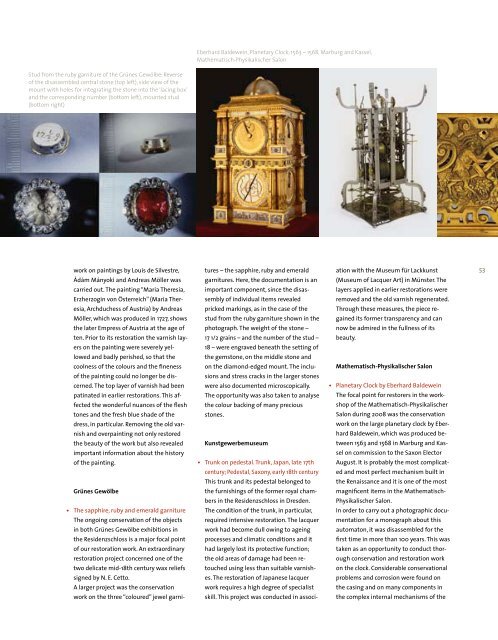2008 - Staatliche Kunstsammlungen Dresden
2008 - Staatliche Kunstsammlungen Dresden
2008 - Staatliche Kunstsammlungen Dresden
You also want an ePaper? Increase the reach of your titles
YUMPU automatically turns print PDFs into web optimized ePapers that Google loves.
Stud from the ruby garniture of the Grünes Gewölbe: Reverse<br />
of the disassembled central stone (top left), side view of the<br />
mount with holes for integrating the stone into the ‘lacing box’<br />
and the corresponding number (bottom left), mounted stud<br />
(bottom right)<br />
work on paintings by Louis de Silvestre,<br />
Ádám Mányoki and Andreas Möller was<br />
carried out. The painting “Maria Theresia,<br />
Erzherzogin von Österreich” (Maria Theresia,<br />
Archduchess of Austria) by Andreas<br />
Möller, which was produced in 1727, shows<br />
the later Empress of Austria at the age of<br />
ten. Prior to its restoration the varnish layers<br />
on the painting were severely yellowed<br />
and badly perished, so that the<br />
coolness of the colours and the fineness<br />
of the painting could no longer be discerned.<br />
The top layer of varnish had been<br />
patinated in earlier restorations. This affected<br />
the wonderful nuances of the flesh<br />
tones and the fresh blue shade of the<br />
dress, in particular. Removing the old varnish<br />
and overpainting not only restored<br />
the beauty of the work but also revealed<br />
important information about the history<br />
of the painting.<br />
grünes gewölbe<br />
• The sapphire, ruby and emerald garniture<br />
The ongoing conservation of the objects<br />
in both Grünes Gewölbe exhibitions in<br />
the Residenzschloss is a major focal point<br />
of our restoration work. An extraordinary<br />
restoration project concerned one of the<br />
two delicate mid-18th century wax reliefs<br />
signed by N. E. Cetto.<br />
A larger project was the conservation<br />
work on the three “coloured” jewel garni-<br />
Eberhard Baldewein, Planetary Clock, 1563 – 1568, Marburg and Kassel,<br />
Mathematisch-Physikalischer Salon<br />
•<br />
tures – the sapphire, ruby and emerald<br />
garnitures. Here, the documentation is an<br />
important component, since the disassembly<br />
of individual items revealed<br />
pricked markings, as in the case of the<br />
stud from the ruby garniture shown in the<br />
photograph. The weight of the stone –<br />
17 1/2 grains – and the number of the stud –<br />
18 – were engraved beneath the setting of<br />
the gemstone, on the middle stone and<br />
on the diamond-edged mount. The inclusions<br />
and stress cracks in the larger stones<br />
were also documented microscopically.<br />
The opportunity was also taken to analyse<br />
the colour backing of many precious<br />
stones.<br />
kunstgewerbemuseum<br />
Trunk on pedestal. Trunk, Japan, late 17th<br />
century; Pedestal, Saxony, early 18th century<br />
This trunk and its pedestal belonged to<br />
the furnishings of the former royal chambers<br />
in the Residenzschloss in <strong>Dresden</strong>.<br />
The condition of the trunk, in particular,<br />
required intensive restoration. The lacquer<br />
work had become dull owing to ageing<br />
processes and climatic conditions and it<br />
had largely lost its protective function;<br />
the old areas of damage had been retouched<br />
using less than suitable varnishes.<br />
The restoration of Japanese lacquer<br />
work requires a high degree of specialist<br />
skill. This project was conducted in associ-<br />
ation with the Museum für Lackkunst<br />
(Museum of Lacquer Art) in Münster. The<br />
layers applied in earlier restorations were<br />
removed and the old varnish regenerated.<br />
Through these measures, the piece regained<br />
its former transparency and can<br />
now be admired in the fullness of its<br />
beauty.<br />
mathematisch-Physikalischer salon<br />
• Planetary Clock by Eberhard Baldewein<br />
The focal point for restorers in the workshop<br />
of the Mathematisch-Physikalischer<br />
Salon during <strong>2008</strong> was the conservation<br />
work on the large planetary clock by Eberhard<br />
Baldewein, which was produced between<br />
1563 and 1568 in Marburg and Kassel<br />
on commission to the Saxon Elector<br />
August. It is probably the most complicated<br />
and most perfect mechanism built in<br />
the Renaissance and it is one of the most<br />
magnificent items in the Mathematisch-<br />
Physikalischer Salon.<br />
In order to carry out a photographic documentation<br />
for a monograph about this<br />
automaton, it was disassembled for the<br />
first time in more than 100 years. This was<br />
taken as an opportunity to conduct thorough<br />
conservation and restoration work<br />
on the clock. Considerable conservational<br />
problems and corrosion were found on<br />
the casing and on many components in<br />
the complex internal mechanisms of the<br />
53

















